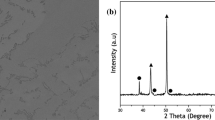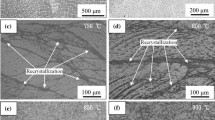Summary
-
1.
During the loading of a hard alloy in uniaxial compression above the proof stress of the alloy, the tungsten carbide grains undergo deformation, as can be discovered from the appearance of slip bands on the grain surface and from the increase in the number of reflections in the X-ray diffraction picture.
-
2.
The picture of strain transfer from one tungsten carbide grain to another exhibits the characteristic features of strain of a polycrystalline body. Slip transfer through an intercrystalline boundary is facilitated when the adjoining grains are similarly oriented, while the slight slip observed in intercrystalline boundaries takes place mainly in the case of a substantial difference in orientation.
-
3.
At equal WC grain size, the ratio of the proof stress to the relative size of contact surface of alloys with different cobalt contents (between 6 and 50%) is, in the first approximation, constant. The deformation of an alloy begins when a certain critical value of stress on the contact surface between carbide grains has been attained. From the physical point of view, this critical stress represents the proof stress of the tungsten carbide at the given grain size and crystal lattice condition.
-
4.
All observations of the deformation process of hard alloys and the structural changes accompanying this process indicate that, in the initial stage of deformation, the laws governing the latter are essentially determined by the deformation of the carbide skeleton. It is only at substantial deformation that the strengthening (workhardening) of the cobalt exerts an influence on the deformation characteristics of hard alloys.
Similar content being viewed by others

Literature cited
R. P. Felgar and J. D. Lubahn, Transactions Society for Testing Materials,57 (1957) p. 770.
C. Nishimatsy and J. Gurland, Transactions of American Ceramic Society for Metals,52, (1960) p. 469.
W. Dawihl and B. Frisch, Archiv für das Eisenhüttenwesen, No 1 (1962) p. 61.
G. V. Samsonov and Ya. S. Umanskii, Hard Compounds of Refractory Metals [in Russian] Moscow, Metallurgizdat (1957) p. 149.
E. A. Anderson and D. C. Jillson, Met. Sept., 1191 (1953).
H. T. Lee and R. M. Brick, Journal of Metals, Feb.147 (1952).
V. A. Ivensen and O. N. Éiduk, Poroshkovaya Met., 156 (1964).
D. McLean, Journal Instit. of Metals, Nov.81, 3 (1952) p. 133.
A. I. Baranov, Yu. F. Lebedev, and V. V. Chernyshev, Collection: Hard Alloys [in Russian] All-Union Scientific Research Institute of Hard Alloys, 4 (1961) p. 125.
Author information
Authors and Affiliations
Rights and permissions
About this article
Cite this article
Ivensen, V.A., Éiduk, O.N. & Pivovarov, L.K. Some deformation regularities of sintered WC-Co hard alloy. Powder Metall Met Ceram 3, 300–310 (1964). https://doi.org/10.1007/BF00774175
Received:
Issue Date:
DOI: https://doi.org/10.1007/BF00774175



